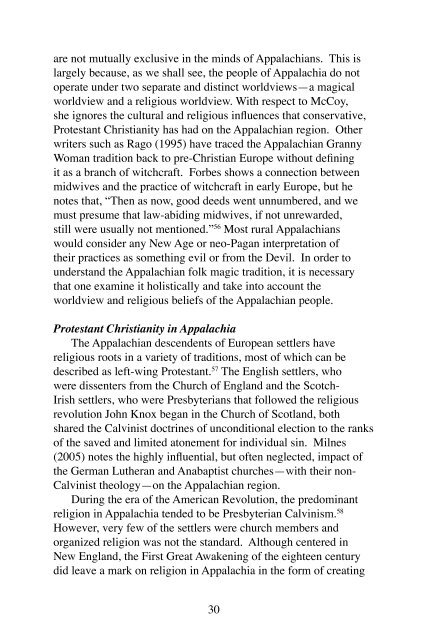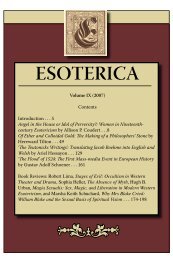Download - Esoterica - Michigan State University
Download - Esoterica - Michigan State University
Download - Esoterica - Michigan State University
Create successful ePaper yourself
Turn your PDF publications into a flip-book with our unique Google optimized e-Paper software.
are not mutually exclusive in the minds of Appalachians. This is<br />
largely because, as we shall see, the people of Appalachia do not<br />
operate under two separate and distinct worldviews—a magical<br />
worldview and a religious worldview. With respect to McCoy,<br />
she ignores the cultural and religious influences that conservative,<br />
Protestant Christianity has had on the Appalachian region. Other<br />
writers such as Rago (1995) have traced the Appalachian Granny<br />
Woman tradition back to pre-Christian Europe without defining<br />
it as a branch of witchcraft. Forbes shows a connection between<br />
midwives and the practice of witchcraft in early Europe, but he<br />
notes that, “Then as now, good deeds went unnumbered, and we<br />
must presume that law-abiding midwives, if not unrewarded,<br />
still were usually not mentioned.” 56 Most rural Appalachians<br />
would consider any New Age or neo-Pagan interpretation of<br />
their practices as something evil or from the Devil. In order to<br />
understand the Appalachian folk magic tradition, it is necessary<br />
that one examine it holistically and take into account the<br />
worldview and religious beliefs of the Appalachian people.<br />
Protestant Christianity in Appalachia<br />
The Appalachian descendents of European settlers have<br />
religious roots in a variety of traditions, most of which can be<br />
described as left-wing Protestant. 57 The English settlers, who<br />
were dissenters from the Church of England and the Scotch-<br />
Irish settlers, who were Presbyterians that followed the religious<br />
revolution John Knox began in the Church of Scotland, both<br />
shared the Calvinist doctrines of unconditional election to the ranks<br />
of the saved and limited atonement for individual sin. Milnes<br />
(2005) notes the highly influential, but often neglected, impact of<br />
the German Lutheran and Anabaptist churches—with their non-<br />
Calvinist theology—on the Appalachian region.<br />
During the era of the American Revolution, the predominant<br />
religion in Appalachia tended to be Presbyterian Calvinism. 58<br />
However, very few of the settlers were church members and<br />
organized religion was not the standard. Although centered in<br />
New England, the First Great Awakening of the eighteen century<br />
did leave a mark on religion in Appalachia in the form of creating<br />
30



